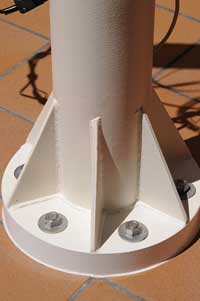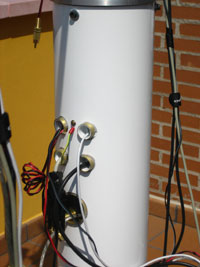I first started using a Losmandy G11 with a Gemini GOTO system. This is a good mount for the money, but I noted inconsistent tracking once I added the TOA 130F. This resulted in lost imaging time, due to many subs with less than perfect stars. I spent many hours tweaking the G11 but finally concluded that I needed an upgrade. In the summer of 2009, I moved to the Takahashi EM400 mount with Temma 2, shown above, which has been a great performer. Chuck Faranda has kindly created a driver for the EM400 Temma 2 system that allows computer control via the ASCOM platform.
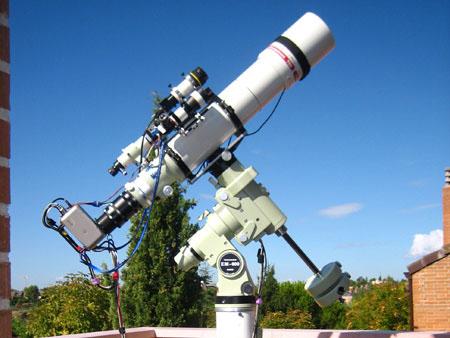
Now this is my main telescope, which I normally use for astrophotography. My imaging configuration consists of:
1.- German Equatorial mount, the EM-400 Temma 2. With a loading capacity of 35 kg, the EM-400 equatorial mount is placed between the JP-Z and the EM-500 but with the ergonomics of the EM-200. Composed of 3 dismountable parts, it is easier to transport and more rapid to implement that the JP-Z. Moreover, integration of the electronic parts inside keeps safely all the fragile elements. It is ideal for the itinerant observers wishing to take advantage of their optical tubes under the best night skies, like for instance TOA-150 refractor or Mewlon-250 reflector.
The EM-400 is equipped with the Temma-2 automatic pointing system, controllable by computer. It is compatible with the majority of the software used by the astronomers amateurs (via the ASCOM interface, for example), whether it is Windows, MacOSX or Linux operating systems.
2.- TOA-130F Takahashi Ortho-Apochromat Series. This 21st century innovation employs a newly designed triplet using special elements to produce the highest order of color correction, hence the name Ortho-Apochromat and is packaged in a short 32" tube with the lens shade retracted.
This instrument is offered with the 4" focuser and built-in camera angle adjuster.
The high order of color correction of the Ortho-Apochromat Series produces images with saturated color and thanks to the numerous knife-edged baffles, an image with amazing contrast.
The apochromatic objective with triplet ED of TOA-130 (D=130mm, F=1000mm, F/D 7,7) is assembled in an extremely neat and precise barrel mechanical, entirely adjustable. Collimation is easy to realize and makes it possible to adapt perfectly the optical stresses to the conditions of observation or imaging. The tube has a retractable dewshield. Ample back focus, over 200mm from the rear cell, has been designed in to permit the user to use a variety of CCD cameras, color filter wheels and electronic focusers or film cameras.
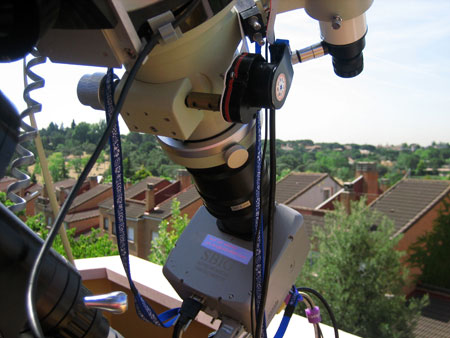
3.- CCD camera from SBIG, the STL 11000M.
Since its introduction, the STL-11000M, 35mm format, has been used in the hands of some of the best astrophotographers in the world to produce some of the most stunning astrophotos ever produced by amateur astronomers.
This equipment is a fixed installation on the terrace roof of my home.
The pier is fastened with bolts onto a plate with 6 stainless steel M16 screws. This plate in turn is welded on the roof floor framework. All covered with concrete, insulation and paving stone.
Inside runs of 5 tubes, allow the cables to connect the equipment with a PC for remote control (mount, STL 11000M and RoboFocus).
The pier is filled with volcanic gravel to absorb any vibrations. After several tests, I found that the vibrations are practically zero.
The polar alignment of EM-400 was realized by the drift method, since Polaris is obstructed from view. In a couple nights I managed an excellent polar alignment.
The RoboFocus motor is installed on the four inch focuser of the TOA-130F by a 'bracket' handmade to measure.
Focusing is performed through FocusMax software developed by Larry Weber and Steve Brady. This is free and fully recommended.
The pier is filled with volcanic gravel to absorb any vibrations. After several tests, I found that the vibrations are practically zero.
The polar alignment of EM-400 was realized by the drift method, since Polaris was obstructed from view. In a couple nights I managed an excellent polar alignment.
The RoboFocus motor is installed on the focuser TOA-130F by a 'bracket' hand made to measure
Focusing is performed through FocusMax software developed by Larry Weber and Steve Brady. This is a free and fully recommended.
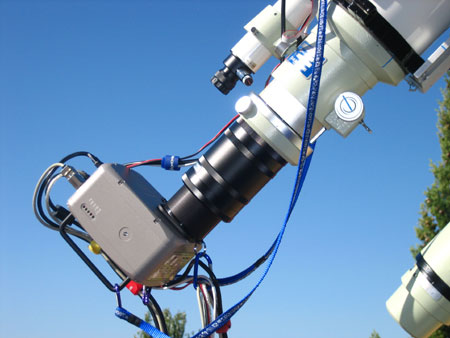
After many years of dedication to Film astrophotography, I decided to "leap" to digital imaging, in part by the discontinued films, which I traditionally used, such as Kodak Technical Pan 2415 and also the higher resolution and performance offered by the current CCD's.
The SBIG STL 11000M (Santa Barbara Instrument Group) has a KAI-11000M sensor with 11 million pixels (4008x2672) interline and 9x9 µm pixel size. It's like using a traditional 35mm size negative but CCD. It comes equipped with an internal filter wheel. I have 2 sets, LRGB filters and Narrowband filters, all made by Baader.
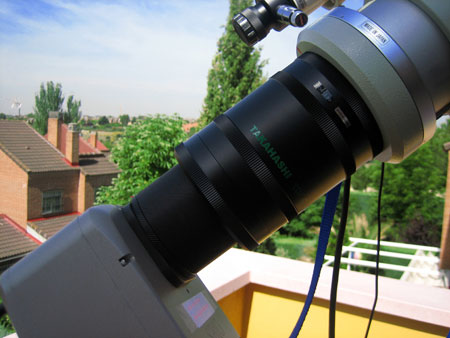
In order to achieve a flat field, the TOA-130F is fitted with a field flattener. This is the Takahashi 6X7 Flattener, I can get very sharp stars to the edges of my field with the STL 11000M. I'm happy with this accessory, it's a great solution.
I also use an anti-pollution filter. This is the IDAS-LPS (Light Pollution Suppression) of Hutech Astronomical Products. This filter, mounted permanently on Feldstein 6, it works fine, removes some gradients that are caused by the action of light pollution.
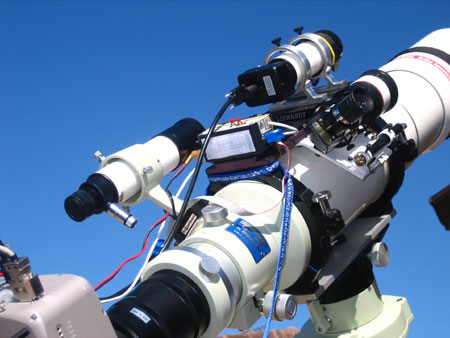
I first started tracking with an eyepiece with illuminated reticule and a Vixen refractor 80/910. After that, came the automatic tracking, my SBIG ST-4 made tracking so much more relaxed and precise. Today, I can track in two ways: one with the dual sensor that cames with the STL 11000M and other with a Remote Guide Head. In both cases it is a CCD sensor with 657x495 pixels of TC237 with a size of 7.4x7.4 µm per pixel. I use the remote option for convenience, allowing good stars for the tracking without being affected by the use of such restrictive filters in the filter wheel of main camera.
With this system it is not necessary to use the focal length of the main telescope for guiding. Now with only 100mm focal length (e.g. SBIG's e-finder), I can do acceptable tracking, to even over 2000mm focal length with excellent results.
In the picture you can see an older and transformed finder scope 8x50 for this purpose. A machined the back part of 1 ¼" inside diameter sufficient to install the remote guide head. Now with a focal length of about 176mm I can do tracking with guaranteed success.
